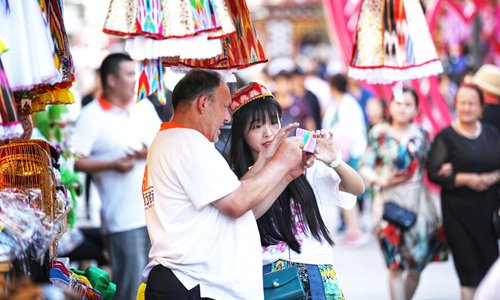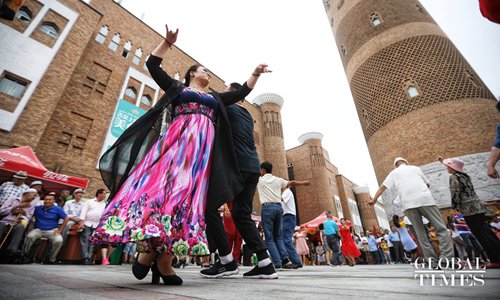Xinjiang residents hail improved livelihood, stability a decade after Urumqi riot
Poverty eradication has blunted extremist influence in Xinjiang

A tourist (right) talks with a vendor at a shopping area at the Grand Bazaar in Urumqi, capital of Northwest China’s Xinjiang Uyghur Autonomous Region on Friday. The Grand Bazaar is famous for specialties in Xinjiang, such as food and clothing of ethnic minority groups in the region. Photo: Cui Meng/GT

Xinjiang residents dance in a square at the Grand Bazaar in Urumqi, capital of Northwest China's Xinjiang Uyghur Autonomous Region on Thursday. Photo: Cui Meng/GT
As one of the main roads that run through the downtown district of Urumqi, capital city of Northwest China's Xinjiang Uyghur Autonomous Region, Jiefangnan Road sees cars and thousands of passersby every day.
The doors to shops along the road are wide open with their owners standing outside to solicit customers. Some elderly sit by the road, chatting and laughing. Naughty boys playing around make faces at their parents after being scolded.
A glimpse of what is happening along Jiefangnan Road may give visitors a view of the local residents' peaceful and abundant life. However, it was a totally different scene on Jiefangnan Road ten years ago.
"Buses were turned upside down on the roads. Cars were smashed and set on fire. I never saw this in my life," Yili, a 28-year-old man from the Kirgiz ethnic group who lives in Urumqi, recalled his experience on July 5, 2009.
Yili told the Global Times that he happened to see three men with knives and bricks in their hands. He saw blood on the knives and was terrified. That was the worse time in his life.
On July 5, 2009, terrorists and rioters gathered along Jiefangnan Road and Heping Road. They smashed shops, turned buses and cars upside down and set them on fire. They beat and attacked people in the area, according to witnesses reached by the Global Times.
The riot, which was engineered by the "East Turkistan" terrorists inside and outside China, caused 197 deaths and injured 1,700. A total of 331 stores and 1,325 vehicles were smashed and burned, and many public facilities were damaged, according to a white paper released by the State Council Information Office in March.
"Terrorist and extremist forces in Xinjiang, driven by the goal of separatism, engaged in sabotage activities. This badly undermined local stability and brought enormous suffering to all ethnic groups in the region," according to the white paper.
Fighting terrorism and extremism to safeguard social stability has become a consensus of all ethnic groups living in Xinjiang. Security has been greatly improved in the past 10 years, especially since the regional government took multiple measures on counter-terrorism and de-radicalization, experts said.
In recent years, the regional government in Xinjiang has taken measures on counter-terrorism and de-radicalization in accordance with laws, including launching vocational education and training centers to help people guilty of minor crimes and those who have been influenced by terrorism and extremism.
Focus has also been put on improving people's living standards.
Hotan is located in southern Xinjiang. It used to be plagued by extremism and once the main battlefield of de-radicalization, as well as poverty.
The lack of arable land, slow infrastructure construction, and frequent drought and bad weather conditions have led many people in Hotan to live a poverty-stricken life.
Take Ayidingkule village in Hotan. The village has 2,076 residents while the arable land is 710 mu (47 hectares), which means per capita arable land is 0.35 mu, according to Yang Jinping, head of the working team stationed in the village.
"Lack of arable land is the main reason for poverty in the village. Having less labor force and vocational skills also worsens the situation," Yang told the Global Times.
To lead the village out of poverty, Yang and the working team decided to develop some industries. But instead of running a garments plant like many other places have done in Hotan, they began to produce beverage bottles.
With the 730,000 yuan ($106,157) in poverty-alleviation funds, the village built a plant. A total of 14 poverty-stricken residents work in the plant and they can earn at least 1,500 yuan a month, with some as much as 3,700 yuan.
Rehaitebage village has a plant which manufactures brooms. Working in the plant for a year, Marmunisha Aihamaittuohuti earned more than 30,000 yuan while previously she was a housewife with no earnings at all.
"I used to ask my husband for money. But now I can also earn money, and my husband has begun to help with the housework," she said.
Rehaitebage village is also working on building a night food fair. People from poor households can join in running the snack stands for free and they can cooperate with villagers, who are better at cooking, according to Kaderdan Abulimit, head of the working team in Rehaitebage village.
Infrastructure in almost every village in Hotan has been improved with new solar street lamps.
Aside from helping enhance villagers' income, the working team in Ayidingkule village also pays attention to improving residents' living environment. A total of 120 trash cans have been installed in the village with 10 people hired to clean public areas. They get 800 yuan a month.
A total of 120 trash cans have been installed in the village with 10 people hired to clean public areas. They get 800 yuan a month.
"The average yearly income of the villagers has reached 10,070 yuan, compared to 4,000 yuan a decade ago," Yang said.
Increasing villagers' income is one aspect of enhancing their living standards. Work on education and medical treatment also needs to be done.
Wuernishahan Talip lives in Ayidingkule village. She is 79 years old and has cardiac disease.
Luckily, 95 percent of her medical fees are paid by the government and she can get 2,000 yuan a year in allowances. Doctors in the village would give her a regular check-up and help her replace the overdue medicine, Wuernishahan said with tears in her eyes.
Poverty is one reason why villagers easily get influenced by extremism. They used to know little about laws and turned to illegal imams for help, said Kaderdan, head of the working team in Rehaitebage village.
By working hard to shorten the distance between villagers and help them in their daily lives, village officials have helped improve the situation, with more villagers willing to share their worries with them, Kaderdan said.
Xinjiang has added 1.4 million new urban jobs and transferred 8.3 million surplus rural laborers for employment from 2016 to 2018. It has expanded the nine-year compulsory education and provided free three-year preschool education in urban and rural areas in southern Xinjiang. It also provides insurance for serious illnesses and full coverage of centralized treatment for 15 serious illnesses, according to the white paper in March.
As people's standard of living improves, the public provides greater support to the government's counter-terrorism, de-radicalization and stability-maintenance effort.
A safe place to visit
There have been no violent attacks in Xinjiang for nearly three years, which is a great achievement for the region's current policies.
Xie Fen, who runs a shop selling special local products in the Grand Bazaar in Urumqi, told the Global Times that businesses were affected for more than two years after 2009 as fewer tourists came to Xinjiang over security concerns.
"But security has been greatly changed in recent years. People of different ethnic groups live happily together. We now have more tourists coming to Xinjiang," Xie said.
During the peak summer season, thousands of tourists come to the Grand Bazaar every day. They walk in the pedestrian zone, with snack stands along the two sides offering delicious special local food, including nan and roast lamb. Or they can go into one of the clothing or carpet shops for a closer look at the lives of different ethnic groups.
A tourist surnamed Song told the Global Times that his family came from Beijing to Xinjiang for a holiday. "Urumqi is a very safe place! We are attracted by Xinjiang's natural landscape and local traditions. I would like to recommend this place to people who have never been here!"
The stable situation in Xinjiang not only attracted domestic visitors but also those from other countries.
Hiroshi Konno, a Japanese tourist, said he has stayed in Kashi in southern Xinjiang for two days and he was attracted by the unique architecture.
"When I was in Japan, I always heard negative news about Xinjiang from the media. But it turns out that these reports were unreliable. Only those who come to Xinjiang can know what is really happening here," he said.
According to data from the Xinhua News Agency, Kashi received nearly 1.24 million tourist trips from January to April, an increase of 30.8 percent from the previous year, hitting a historic high.
Abulikemu Ahoti has been selling honey for ten years in Kashi, a place that has become a popular spot for tourists in recent years.
Abulikemu told the Global Times that more tourists come to Kashi now and he earns at least 3,000 yuan a day. He also gets acquainted with tourists who buy his honey several times.
Memeti Yiming's shop of traditional musical instruments of ethnic groups in Xinjiang has also been doing brisk business. He said he sold 2,000 hand-made drums within a few minutes on Friday.
The Global Times reporter saw on Friday that most of the residents in Kashi live a leisurely and comfortable life - the elderly sit in a teahouse near the Id Kah Mosque and chat, while children play around trees.
People who live in Xinjiang are best qualified to say whether they are happy or not. For the past 10 years, residents of all ethnic groups have been working together to make sure what happened in 2009 doesn't happen again, and are working together for a better future, residents in Xinjiang said.

